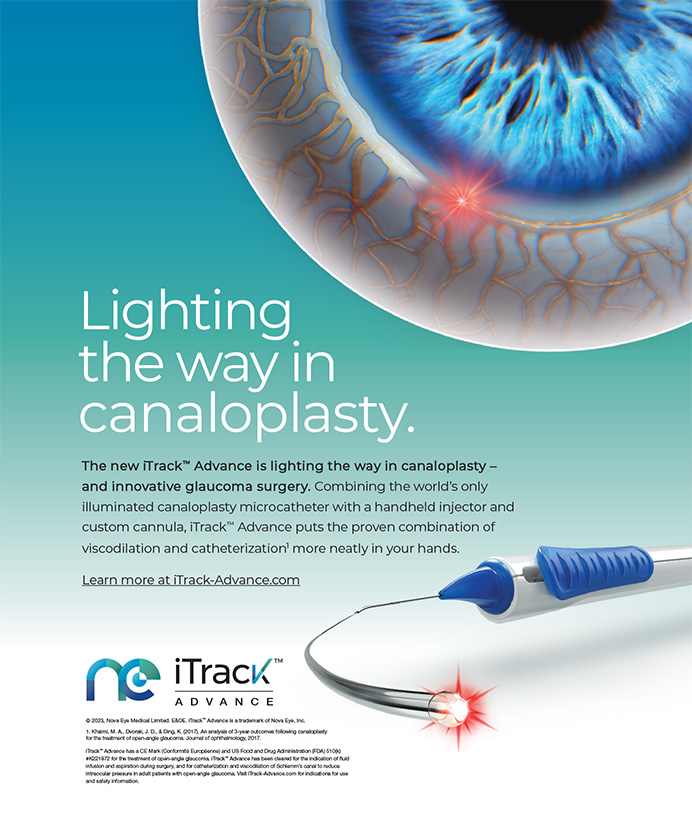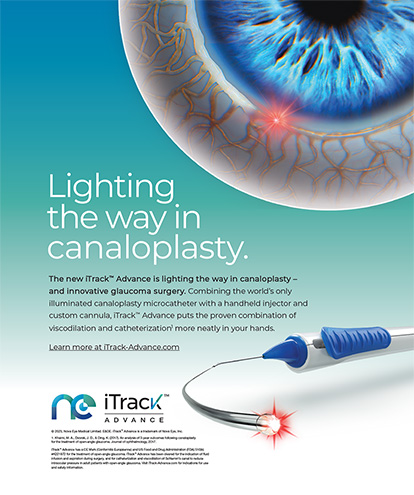Cover Stories | Jun 2005
Providing a Full Spectrum of Vision
An assessment of clinical options for treating presbyopia with IOLs.
Richard L. Lindstrom, MD
The During the past 2 decades, I have found several ways to reduce a presbyopic patient's dependence on eyeglasses for distance, intermediate, and near vision. Each approach has its advantages and disadvantages.
METHODS FOR ADDRESSING PRESBYOPIA
Blended Vision
The first option involves the bilateral implantation of two monofocal IOLs. In this scenario, it is not necessary to implant lenses of the exact same power in both eyes. For example, the surgeon can target the patient's dominant eye for plano and his nondominant eye for 0.75D. This approach is commonly referred to as blended vision or micromonovision. It offers the advantage of good distance vision, but the patient will require a 0.50D intermediate add or a 0.75D near add.
Standard Monovision
In standard monovision, the surgeon targets a plano result for the patient's dominant eye and -2.50D in his other eye. The dominant eye will see 20/20 at distance but will have poor intermediate and near vision. The other eye will see 20/200 at distance and will have poor intermediate but good near visual acuity. The drawbacks to this approach are that the patient forsakes intermediate vision, loses stereopsis, and experiences a significant disparity between his two eyes that may result in a mild relative amblyopia in the eye targeted for near vision.
Bilateral Multifocality
Another option is to implant a multifocal IOL in both eyes. Multifocal lenses can provide functional vision at distance and near, but they offer a reduced quality of vision, decreased contrast sensitivity, night vision symptoms such as halos, and some distortions of color. Many multifocal lenses also provide poor intermediate vision, which has become more important in the modern world of computers.
An Accommodating Lens
When implanted bilaterally, the Crystalens (Eyeonics, Inc., Aliso Viejo, CA) provides excellent distance and intermediate vision. Most patients will require a small add of +1.25D initially for very fine near work, but it can and should be reduced to between +0.50 and +0.75D at 1 year (see sidebar entitled Crystalens Concepts). In order to enhance patients' near vision, one can target slight myopia (range, -0.50 to -0.75D) in their nondominant eye. I currently favor this clinical approach for most patients.
Two Different Implants
Lastly, one may implant dissimilar lenses in patients' eyes. For example, the surgeon could place a Crystalens in the dominant eye and a multifocal IOL in the nondominant eye. Among the potential advantages of this approach, the patient's dominant eye with the Crystalens will have good distance and intermediate vision with no loss of contrast sensitivity or halos—important qualities for distance function and driving. The nondominant eye with a multifocal IOL will see well at distance and near, retain stereopsis, and have no risk of amblyopia. By using his eyes together, the patient will have a full range of vision, which might be termed seamless vision.
Although both eyes will have quality distance vision, the multifocal IOL will provide slightly worse distance acuity because it splits light rays into two focal points. The unique advantage of the Crystalens in the dominant eye is that it provides high-quality intermediate vision for daily activities such as computer work. The eye with a multifocal implant will provide stronger near visual acuity in the J1 to J2 range. In my experience, implanting a multifocal IOL only in the nondominant eye improves the patient's tolerance of a loss of contrast sensitivity, a decrease in the quality of distance vision, the incidence of halos at night, and color distortion.
CONCLUSION
Ophthalmologists should understand the IOL options for addressing presbyopia so that they may choose the best option for each individual. In particular, I think that combining the Crystalens with a multifocal IOL will prove to be an excellent strategy for many patients.
Richard L. Lindstrom, MD, is Founder and Attending Surgeon, Minnesota Eye Consultants, and Adjunct Professor Emeritus at the University of Minnesota in Minneapolis. He is a consultant for Eyeonics, Inc.; Advanced Medical Optics, Inc; Bausch & Lomb; and Alcon Laboratories, Inc. Dr. Lindstrom may be reached at (952) 888-5800; rllindstrom@mneye.com.


